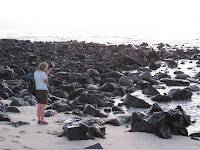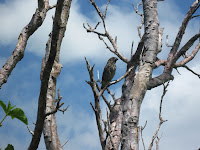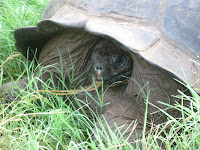I knew this was going to be a trip emphazing wildlife when we checked into our Guayaquil hostal the night before leaving for the islands and saw a cage of Pygmy Marmoset Monkeys from the Amazon there in the lobby.
Of course, us being us we couldn't make up our minds and so we did both.
We flew into Isla San Cristobal and had our first taste of the animals being in charge.
Everything here is about tourism and the reason everyone comes is because the wildlife is not afraid of people. As a matter of fact, they are indifferent which is new for humans. The sea lions (lobo marinos/sea wolves) go where ever they want and do what ever they please.




So, we set off exploring on our own and getting the "lay of the land."
The reason the "Origin of the Species" lightbulb turned on for Charles Darwin was this little guy, the Darwin Finch. They are everywhere and everywhere they are a little different...different colors and different beaks for eating different foods on all the different Galapagos Islands.
Tijeretas means scissors and this is what the frigate birds are called because of the tail feathers.






This was the first of many beaches we visited, Bahia Tortuga, which was a short hike to the southwest from the main port city of Puerto Barquerizo Moreno through a cactus forest.


Later, we jumped in a p/u truck cab to take a ride out to Frigate Hill and, on top, El Junco, a volcano with fresh water in its crater, where the scissor birds bathe themselves to get all the salt off their feathers after spending so many days out at sea.
On another day, we went out to a turtle hatchery/breeding station, Galapaguera de Cerro Colorado, where they paint birthdays on their shell backs.
The next beach had whale bones which Joella convinced me would not fit in my suitcase even though I really wanted one for a paperweight on my desk.




The tree cactus, Oputina, seemed to be pretty much the national flower and Bull Seal was the Mayor. There is another white hardwood tree that the first docks were built with and which lasted longer than the metal docks.




Everynight holds a sunrise and then a sunset in store when you live on a small island.
Where you find tourists, you will find artists trying to sell them something and where you find outdoor fish markets, you'll find pelicans waiting for free handouts.
Here's a black Darwin Finch, as oppossed to the earlier yellow one, and hundreds of black marine iguanas (which look like black lava rocks, but they're not) at the Playa Lobos Marinos.









After four days of hopping around on our own, we ferried over to Isla Santa Cruz and got on our Cruise ship/ Yate (yacht), The Amigo, for another four days to watch, listen and learn from our tour guide, Raphael. The ship would travel overnight from island to island, so that when we woke up we were somewhere new and another adventure awaited us.
In the yate's small launch, we first went in to Bahia Tortuga Negra's red and white mangrove lagoon to look at black turtles, blue-footed Boobies, Naughty Terns and baby, black-tipped reef sharks. Everywhere there were Sally lightfoot crabs that seemed able to walk on water.
The Amigo was set up to accomodate 16 tourists, but there were only six of us; whereas the National Geographic yate behind me took hundreds onboard and cost thousands more per day.
All the islands; Bartolome, Sullivan Bay, Chinaman's Hat, etc.; were once volcanos and volcanos make lava. There are two kinds of lava that flows: the Ah-Ah lava hurt which comes from violent explosions which is light weight and the pah-hoe-hoe which looks like coils of rope and flows.








Lava cactus is about the only thing that grows on these barren rocks, but you might see the a lovely little Galapagos Dove with its beautiful blue eyes.


One morning we motored off earlier than usual to get to a crater lake where over fifty flamingos were waiting for us and we were able to watch them wake up and have breakfast while we had ours from the deck of the Amigo.





One morning we motored off earlier than usual to get to a crater lake where over fifty flamingos were waiting for us and we were able to watch them wake up and have breakfast while we had ours from the deck of the Amigo.



Amother day, we went on a 2 hr. hike up Cerro Dragon, Dragon Hill, which is named for its inhabitants. So, as we hiked we came across not large dogs crashing through the brush, but the native large, red & yellow Land Iguanas










But, like all good things it had to come to an end, so sailed off and returned to Admiralty Bay and Santa Cruz's Puerto Ayora , with its small, hard-working fishing boats and statues to lizards.




Raphael was not to be denied though and there would, however, be one more excursion...
Here I, who shall be known forever more as the turtle whisperer, am saying good-be to my old friend, Lonesome George who reminded me of Sebo Dave, not only for his looks, but because he kept saying he liked Joella better.


Here is the proverbial parting shop of Raphael, who looked a lot like my Dad-but that's another story, and his gang of six.

















































